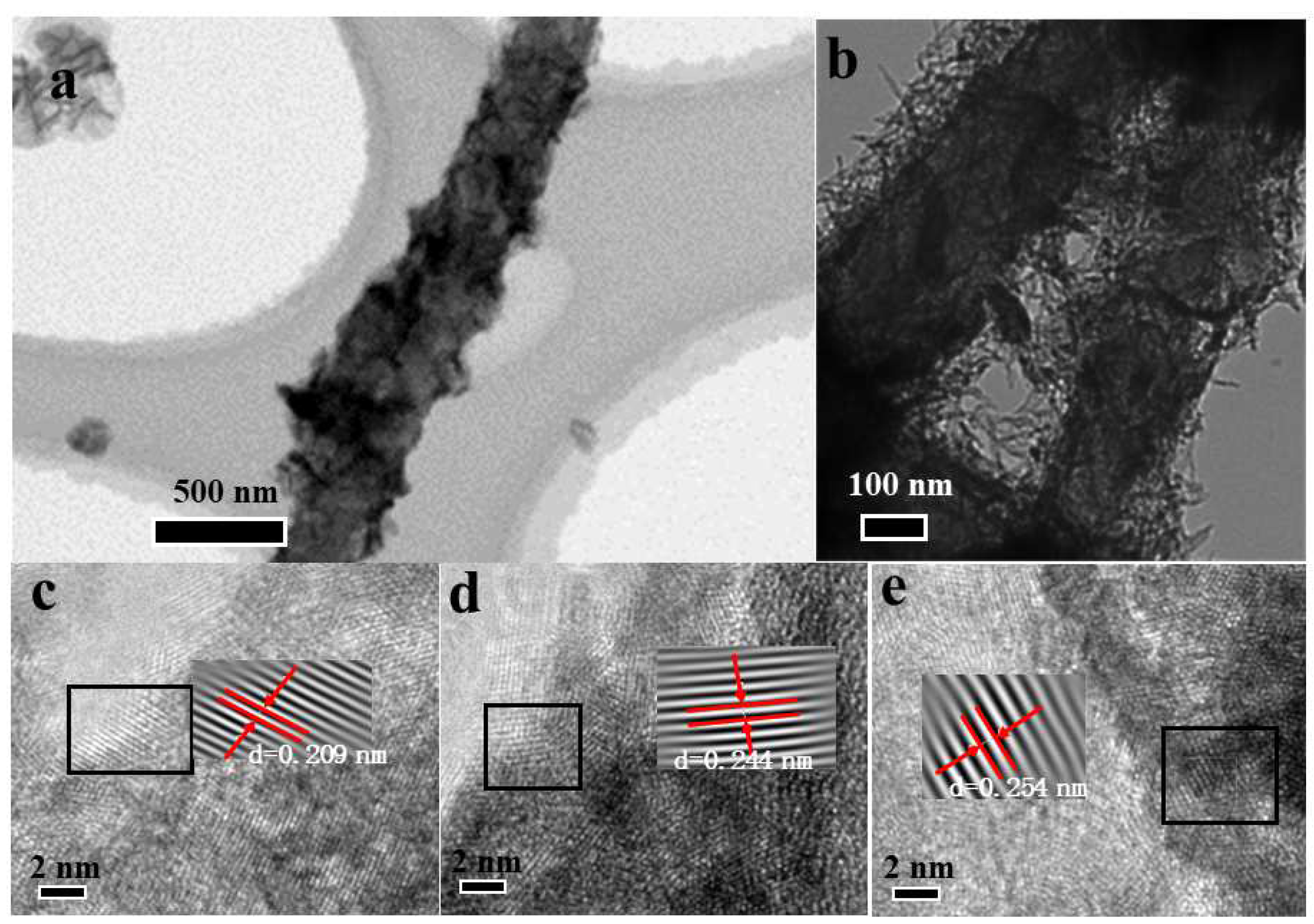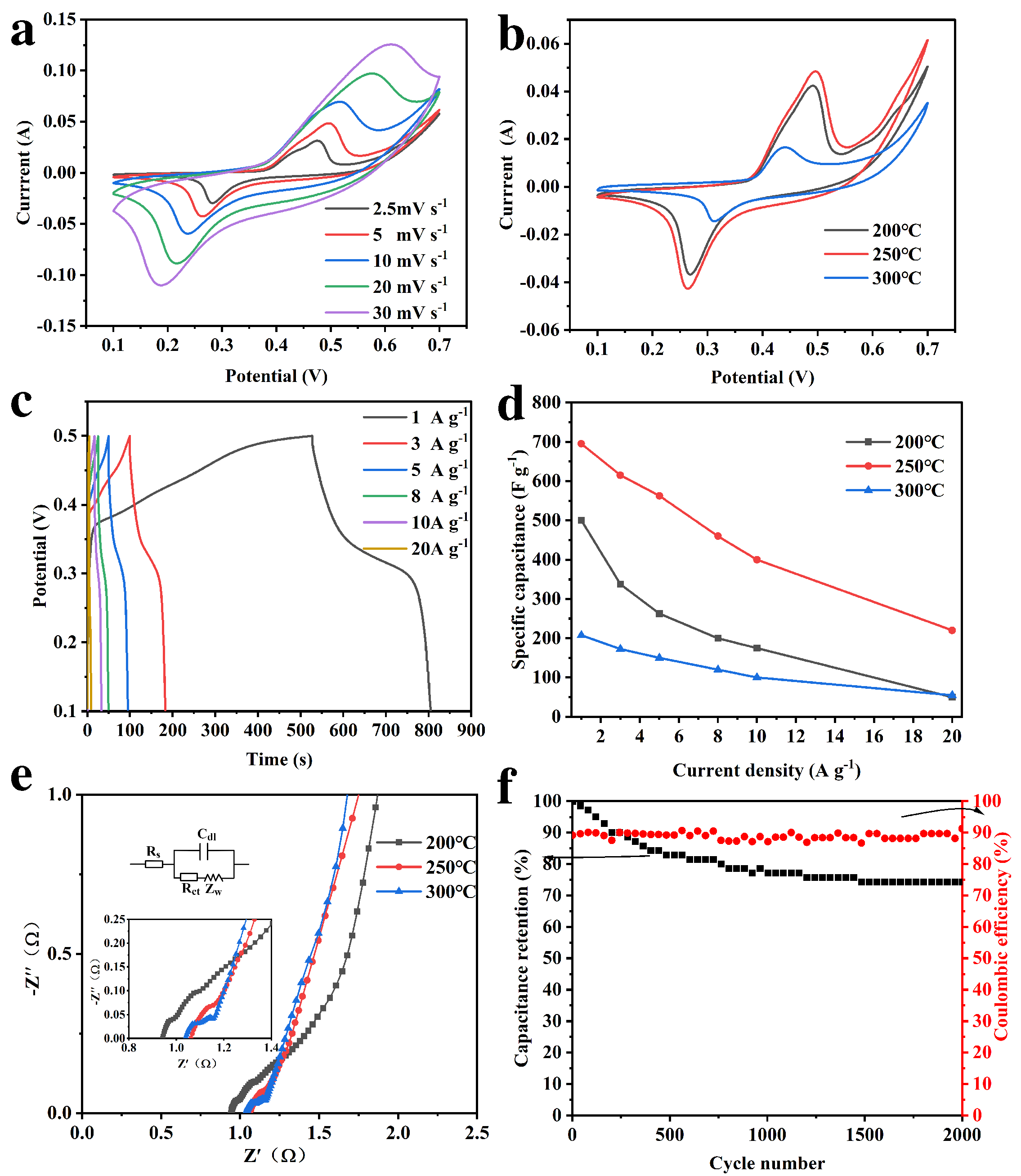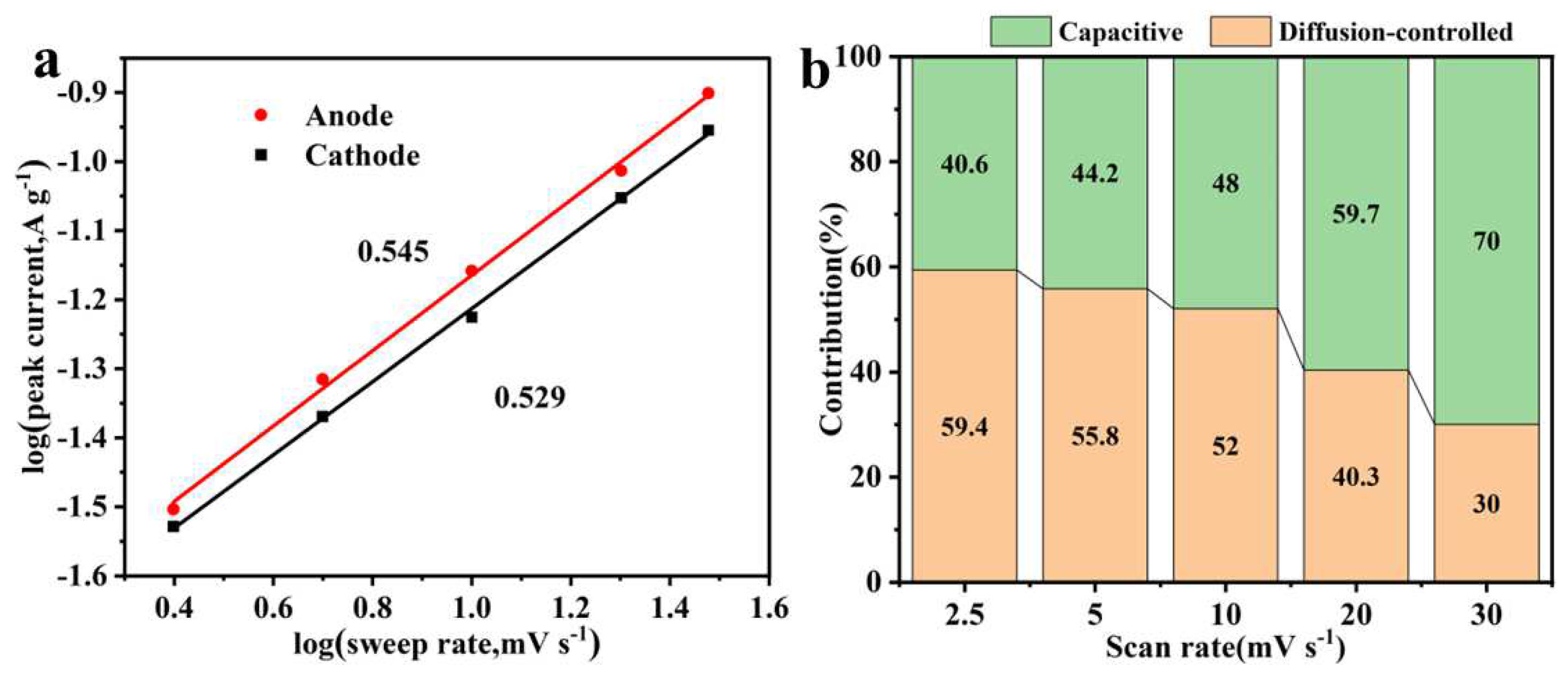Core-Shell Carbon Nanofibers@Ni(OH)2/NiO Composites for High-Performance Asymmetric Supercapacitors
Abstract
:1. Introduction
2. Experimental Section
2.1. Preparation of CNFs@Ni(OH)2/NiO
2.2. Preparation of CNFs@Ni(OH)2/NiO-X Electrodes and ASC Assembly
2.3. Electrochemical Performance Characterization
3. Results
3.1. Structure and Morphology Analysis
3.2. Electrochemical Property
4. Conclusions
Supplementary Materials
Author Contributions
Funding
Institutional Review Board Statement
Informed Consent Statement
Data Availability Statement
Conflicts of Interest
References
- Wang, F.; Wu, X.; Yuan, X.; Liu, Z.; Zhang, Y.; Fu, L.; Zhu, Y.; Zhou, Q.; Wu, Y.; Huang, W. Latest advances in supercapacitors: From new electrode materials to novel device designs. Chem. Soc. Rev. 2017, 46, 6816–6854. [Google Scholar] [CrossRef] [PubMed]
- Ye, C.; Xu, L. Heteroatom-doped porous carbon derived from zeolite imidazole framework/polymer core-shell fibers as an electrode material for supercapacitor. Compos. Part B-Eng. 2021, 225, 109256. [Google Scholar] [CrossRef]
- Tiwari, P.; Janas, D.; Chandra, R. Self-standing MoS2/CNT and MnO2/CNT one dimensional core shell heterostructures for asymmetric supercapacitor application. Carbon 2021, 177, 291–303. [Google Scholar] [CrossRef]
- Abdel Maksoud, M.I.A.; Fahim, R.A.; Shalan, A.E.; Abd Elkodous, M.; Olojede, S.O.; Osman, A.I.; Farrell, C.; Al-Muhtaseb, A.a.H.; Awed, A.S.; Ashour, A.H.; et al. Advanced materials and technologies for supercapacitors used in energy conversion and storage: A review. Environ. Chem. Lett. 2021, 19, 375–439. [Google Scholar] [CrossRef]
- Xiong, S.; Jiang, S.; Wang, J.; Lin, H.; Lin, M.; Weng, S.; Liu, S.; Jiao, Y.; Xu, Y.; Chen, J. A high-performance hybrid supercapacitor with NiO derived NiO@Ni-MOF composite electrodes. Electrochim. Acta 2020, 340, 135956. [Google Scholar] [CrossRef]
- Choudhary, R.B.; Ansari, S.; Purty, B. Robust electrochemical performance of polypyrrole (PPy) and polyindole (PIn) based hybrid electrode materials for supercapacitor application: A review. J. Energy Storage 2020, 29, 101302. [Google Scholar] [CrossRef]
- Zhang, X.; Zhang, Z.; Xiong, R.; Xu, X.; Tian, X.; Wang, C. High Temperature Modified Covalent Triazine Framework for High-efficiency and Ultra-cycle Stable Symmetric Supercapacitor. Chem. Lett. 2022, 51, 854–858. [Google Scholar] [CrossRef]
- Wang, Y.; Zhang, L.; Hou, H.; Xu, W.; Duan, G.; He, S.; Liu, K.; Jiang, S. Recent progress in carbon-based materials for supercapacitor electrodes: A review. J. Mater Sci. 2021, 56, 173–200. [Google Scholar] [CrossRef]
- Schiavi, P.G.; Altimari, P.; Marzolo, F.; Rubino, A.; Zanoni, R.; Pagnanelli, F. Optimizing the structure of Ni–Ni(OH)2/NiO core-shell nanowire electrodes for application in pseudocapacitors: The influence of metallic core, Ni(OH)2/NiO ratio and nanowire length. J. Alloy Compd. 2021, 856, 157718. [Google Scholar] [CrossRef]
- Su, L.; Gong, L.; Wang, X.; Pan, H. Improved low-temperature performance of novel asymmetric supercapacitor with capacitor/battery-capacitor construction. Int. J. Energy Res. 2016, 40, 763–769. [Google Scholar] [CrossRef]
- Zuo, Y.; Ni, J.-J.; Song, J.-M.; Niu, H.-L.; Mao, C.-J.; Zhang, S.-Y.; Shen, Y.-H. Synthesis of Co3O4/NiO nanofilms and their enhanced electrochemical performance for supercapacitor application. Appl. Surf. Sci. 2016, 370, 528–535. [Google Scholar] [CrossRef] [Green Version]
- Kim, S.-I.; Lee, J.-S.; Ahn, H.-J.; Song, H.-K.; Jang, J.-H. Facile Route to an Efficient NiO Supercapacitor with a Three-Dimensional Nanonetwork Morphology. ACS Appl. Mater Inter. 2013, 5, 1596–1603. [Google Scholar] [CrossRef]
- Xiao, H.; Yao, S.; Liu, H.; Qu, F.; Zhang, X.; Wu, X. NiO nanosheet assembles for supercapacitor electrode materials. Prog. Nat. Sci. Mater. Int. 2016, 26, 271–275. [Google Scholar] [CrossRef] [Green Version]
- Dai, X.; Chen, D.; Fan, H.; Zhong, Y.; Chang, L.; Shao, H.; Wang, J.; Zhang, J.; Cao, C.-n. Ni(OH)2/NiO/Ni composite nanotube arrays for high-performance supercapacitors. Electrochim. Acta 2015, 154, 128–135. [Google Scholar] [CrossRef]
- Manibalan, G.; Govindaraj, Y.; Yesuraj, J.; Kuppusami, P.; Murugadoss, G.; Murugavel, R.; Rajesh Kumar, M. Facile synthesis of NiO@Ni(OH)2-α-MoO3 nanocomposite for enhanced solid-state symmetric supercapacitor application. J. Colloid Interface Sci. 2021, 585, 505–518. [Google Scholar] [CrossRef]
- Gao, X.; Zhang, H.; Guo, E.; Yao, F.; Wang, Z.; Yue, H. Hybrid two-dimensional nickel oxide-reduced graphene oxide nanosheets for supercapacitor electrodes. Microchem. J. 2021, 164, 105979. [Google Scholar] [CrossRef]
- Yin, J.; Ahmed, A.; Xu, L. High-Throughput Free Surface Electrospinning Using Solution Reservoirs with Different Depths and Its Preparation Mechanism Study. Adv. Fiber Mater. 2021, 3, 251–264. [Google Scholar] [CrossRef]
- Ye, C.-W.; Xu, L. Recent advances in the design of a high performance metal–nitrogen–carbon catalyst for the oxygen reduction reaction. J. Mater Chem. A 2021, 9, 22218–22247. [Google Scholar] [CrossRef]
- Yewale, M.A.; Kadam, R.A.; Kaushik, N.K.; Nguyen, L.N.; Nakate, U.T.; Lingamdinne, L.P.; Koduru, J.R.; Auti, P.S.; Vattikuti, S.V.P.; Shin, D.K. Electrochemical supercapacitor performance of NiCo2O4 nanoballs structured electrodes prepared via hydrothermal route with varying reaction time. Colloids Surf. A Physicochem. Eng. Asp. 2022, 653, 129901. [Google Scholar] [CrossRef]
- Gunasekaran, S.S.; Gopalakrishnan, A.; Subashchandrabose, R.; Badhulika, S. Phytogenic generation of NiO nanoparticles as green-electrode material for high performance asymmetric supercapacitor applications. J. Energy Storage 2021, 37, 102412. [Google Scholar] [CrossRef]
- Wu, M.-S.; Hsieh, H.-H. Nickel oxide/hydroxide nanoplatelets synthesized by chemical precipitation for electrochemical capacitors. Electrochim. Acta 2008, 53, 3427–3435. [Google Scholar] [CrossRef]
- Yuan, Y.F.; Lin, J.X.; Zhang, D.; Yin, S.M.; Zhao, Y.L.; Yang, J.L.; Chen, Y.B.; Guo, S.Y. Freestanding hierarchical NiO/MnO2 core/shell nanocomposite arrays for high-performance electrochemical energy storage. Electrochim. Acta 2017, 227, 303–309. [Google Scholar] [CrossRef]
- Li, J.; Cao, W.; Zhou, N.; Xu, F.; Chen, N.; Liu, Y.; Du, G. Hierarchically nanostructured Ni(OH)2–MnO2@C ternary composites derived from Ni-MOFs grown on nickel foam as high-performance integrated electrodes for hybrid supercapacitors. Electrochim. Acta 2020, 343, 136139. [Google Scholar] [CrossRef]
- Wang, X.; Wang, X.; Yi, L.; Liu, L.; Dai, Y.; Wu, H. Preparation and capacitive properties of the core–shell structure carbon aerogel microbeads- nanowhisker-like NiO composites. J. Power Sources 2013, 224, 317–323. [Google Scholar] [CrossRef]
- Zhao, B.; Liu, Q.; Chen, Y.; Liu, Q.; Yu, Q.; Wu, H.B. Interface-Induced Pseudocapacitance in Nonporous Heterogeneous Particles for High Volumetric Sodium Storage. Adv. Funct. Mater 2020, 30, 2002019. [Google Scholar] [CrossRef]
- Forghani, M.; Donne, S.W. Method Comparison for Deconvoluting Capacitive and Pseudo-Capacitive Contributions to Electrochemical Capacitor Electrode Behavior. J. Electrochem. Soc. 2018, 165, A664. [Google Scholar] [CrossRef]
- Zhu, S.J.; Jia, J.Q.; Wang, T.; Zhao, D.; Yang, J.; Dong, F.; Shang, Z.G.; Zhang, Y.X. Rational design of octahedron and nanowire CeO2@MnO2 core–shell heterostructures with outstanding rate capability for asymmetric supercapacitors. Chem. Commun. 2015, 51, 14840–14843. [Google Scholar] [CrossRef] [PubMed]
- Zhang, G.; Qin, P.; Nasser, R.; Li, S.; Chen, P.; Song, J. Synthesis of Co(CO3)0.5(OH)/Ni2(CO3)(OH)2 nanobelts and their application in flexible all-solid-state asymmetric supercapacitor. Chem. Eng. J. 2020, 387, 124029. [Google Scholar] [CrossRef]
- Sethi, M.; Shenoy, U.S.; Bhat, D.K. Hassle-free solvothermal synthesis of NiO nanoflakes for supercapacitor application. Phys. B Condens. Matter 2021, 611, 412959. [Google Scholar] [CrossRef]
- Li, Y.; Wei, Q.; Wang, R.; Zhao, J.; Quan, Z.; Zhan, T.; Li, D.; Xu, J.; Teng, H.; Hou, W. 3D hierarchical porous nitrogen-doped carbon/Ni@NiO nanocomposites self-templated by cross-linked polyacrylamide gel for high performance supercapacitor electrode. J. Colloid Interface Sci. 2020, 570, 286–299. [Google Scholar] [CrossRef]
- Cai, D.; Du, J.; Zhu, C.; Cao, Q.; Huang, L.; Wu, J.; Zhou, D.; Xia, Q.; Chen, T.; Guan, C.; et al. Iron Oxide Nanoneedles Anchored on N-Doped Carbon Nanoarrays as an Electrode for High-Performance Hybrid Supercapacitor. ACS Appl. Energy Mater. 2020, 3, 12162–12171. [Google Scholar] [CrossRef]
- Gu, C.D.; Ge, X.; Wang, X.L.; Tu, J.P. Cation–anion double hydrolysis derived layered single metal hydroxide superstructures for boosted supercapacitive energy storage. J. Mater Chem. A 2015, 3, 14228–14238. [Google Scholar] [CrossRef]
- Han, W.; Yuan, L.; Liu, X.; Wang, C.; Li, J. Ultrathin MoSe2 nanosheets decorated on carbon aerogel microspheres for high-capacity supercapacitor electrodes. Electroanal. Chem. 2021, 899, 115643. [Google Scholar] [CrossRef]
- Zhao, Y.; Zhang, Y.; Cheng, Y.; Zhao, W.; Chen, W.; Meng, C.; Huang, C. Synthesis of Co2SiO4/Ni(OH)2 core–shell structure as the supercapacitor electrode material with enhanced electrochemical properties. Mater. Lett. 2021, 282, 128774. [Google Scholar] [CrossRef]
- Liu, H.; Liu, B.; Sun, X.; Han, X.; Cui, J.; Zhang, Y.; He, W. A simple hydrothermal method for the preparation of 3D petal-like Ni(OH)2/g-C3N4/RGO composite with good supercapacitor performance. Inorg. Chem. Commun. 2020, 122, 108263. [Google Scholar] [CrossRef]
- Shin, S.; Shin, M.W. Nickel metal–organic framework (Ni-MOF) derived NiO/C@CNF composite for the application of high performance self-standing supercapacitor electrode. Appl. Surf. Sci. 2021, 540, 148295. [Google Scholar] [CrossRef]
- Shi, H.; Ma, M.; Liu, P.; Jia, X.; Yang, F.; Zhao, B.; Li, Z. Preparation of petal-particle cross-linking flowerlike NiO for supercapacitor application. J. Electroanal. Chem. 2020, 876, 114481. [Google Scholar] [CrossRef]








| Element | Atomic % (200) | Atomic % (250) | Atomic % (300) |
|---|---|---|---|
| Carbon | 76.266 | 60.947 | 69.428 |
| Nitrogen | 1.824 | 1.636 | 2.174 |
| Oxygen | 7.013 | 11.671 | 7.662 |
| Nickel | 14.896 | 25.746 | 20.736 |
| SA (m2 g−1) | VT (cm3 g−1) | VS (cm3 g−1) | VI (cm3 g−1) | Wavg (nm) |
|---|---|---|---|---|
| 49.299 | 0.116 | 0.010 | 0.106 | 7.212 |
Publisher’s Note: MDPI stays neutral with regard to jurisdictional claims in published maps and institutional affiliations. |
© 2022 by the authors. Licensee MDPI, Basel, Switzerland. This article is an open access article distributed under the terms and conditions of the Creative Commons Attribution (CC BY) license (https://creativecommons.org/licenses/by/4.0/).
Share and Cite
Fan, P.; Xu, L. Core-Shell Carbon Nanofibers@Ni(OH)2/NiO Composites for High-Performance Asymmetric Supercapacitors. Materials 2022, 15, 8377. https://doi.org/10.3390/ma15238377
Fan P, Xu L. Core-Shell Carbon Nanofibers@Ni(OH)2/NiO Composites for High-Performance Asymmetric Supercapacitors. Materials. 2022; 15(23):8377. https://doi.org/10.3390/ma15238377
Chicago/Turabian StyleFan, Peizhi, and Lan Xu. 2022. "Core-Shell Carbon Nanofibers@Ni(OH)2/NiO Composites for High-Performance Asymmetric Supercapacitors" Materials 15, no. 23: 8377. https://doi.org/10.3390/ma15238377





